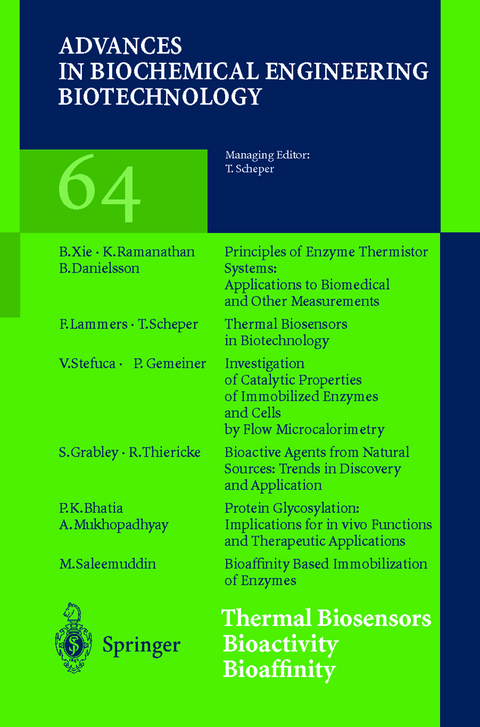
Thermal Biosensors Bioactivity Bioaffinity
Seiten
1998
|
1999
Springer Berlin (Verlag)
978-3-540-64967-0 (ISBN)
Springer Berlin (Verlag)
978-3-540-64967-0 (ISBN)
The immobilized biocatalyst (IMB) is a key component of biotransformation systems that are used to transform substrates to desired products. The impro- ment of biocatalyst properties has a direct influence on the overall effectiveness of the process based on the biotransformation. The basic catalytic characte- stics of biocatalyst that are followed include kinetic properties, pH optima, stability,and inhibition. The investigation of catalytic properties of immobilized enzymes is still a time consuming procedure and is not always simple. In the 1980s,a major effort was made to standardize the rules by which IMB is char- terized. The Working Party of EFB on immobilized biocatalysts has formul- ed principles of individual methods, among them the requirement of kinetic characterization [1]. It was recommended to use a packed-bed reactor,equipped with temperature control and with infinite flow circulation. The system should be equipped with a post-column unit to measure the time-dependence of the product or substrate concentration [2, 3], the most commonly used analytical methods being spectrophotometry, chemiluminiscence, automatic titration, bioluminiscence, chromatography, polarimetry, and biosensors based on the oxygen electrode. There are two main drawbacks to the application of these methods: 1. The need to vary the analytical principles, depending on the chemical and physical-chemical properties of analytes; 2. In some cases, mainly in the study of hydrolytic enzymes, the natural s- strate must be replaced by an artificial one,that is chromolytic,chromogenic, chemiluminiscent,bioluminiscent,or fluorescent.
Principles of Enzyme Thermistor Systems: Applications to Biomedical and Other Measurements.- Thermal Biosensors in Biotechnology.- Investigation of Catalytic Properties of Immobilized Enzymes and Cells by Flow Microcalorimetry.- Bioactive Agents from Natural Sources: Trends in Discovery and Application.- Protein Glycosylation: Implications for In Vivo Functions and Therapeutic Applications.- Bioaffinity Based Immobilization of Enzymes.
| Erscheint lt. Verlag | 4.12.1998 |
|---|---|
| Reihe/Serie | Advances in Biochemical Engineering/Biotechnology |
| Co-Autor | P.K. Bhatia, B. Danielsson, P. Gemeiner, S. Grabley, F. Lammers, A. Mukhopadhyay, K. Ramanathan, M. Saleemuddin, T. Scheper, V. Stefuca, R. Thiericke, B. Xie |
| Zusatzinfo | IX, 239 p. 28 illus. |
| Verlagsort | Berlin |
| Sprache | englisch |
| Maße | 155 x 235 mm |
| Gewicht | 520 g |
| Themenwelt | Naturwissenschaften ► Biologie ► Genetik / Molekularbiologie |
| Naturwissenschaften ► Chemie ► Analytische Chemie | |
| Naturwissenschaften ► Chemie ► Technische Chemie | |
| Technik ► Umwelttechnik / Biotechnologie | |
| Schlagworte | Biosensor • Biotechnology • Chromatography • Hardcover, Softcover / Biologie/Genetik, Gentechnik • HC/Biologie/Genetik, Gentechnik • Protein • sensors |
| ISBN-10 | 3-540-64967-0 / 3540649670 |
| ISBN-13 | 978-3-540-64967-0 / 9783540649670 |
| Zustand | Neuware |
| Haben Sie eine Frage zum Produkt? |
Mehr entdecken
aus dem Bereich
aus dem Bereich
50 Meilensteine der Genetik
Buch | Hardcover (2022)
Librero b.v. (Verlag)
9,95 €


